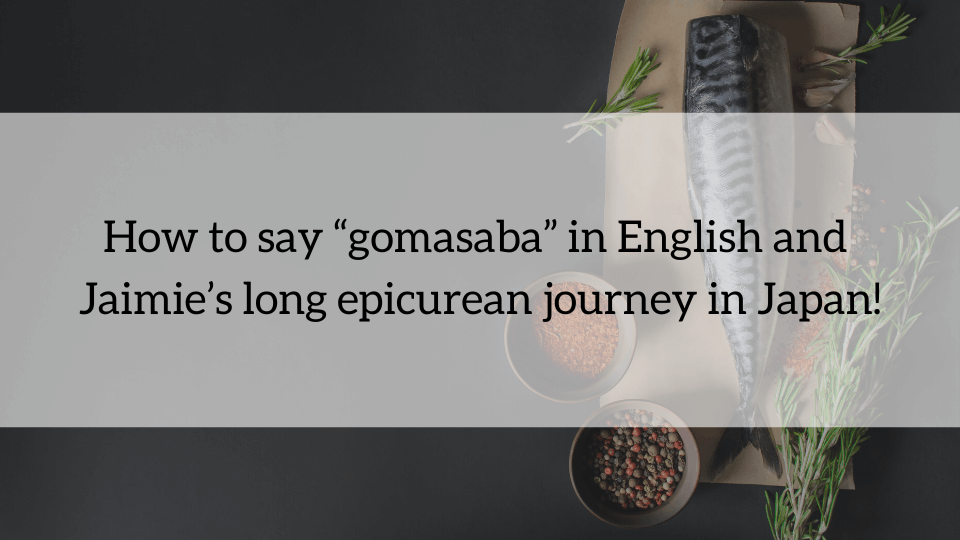みなさん、こんにちは。
まず最初に、私がよく聞かれていそうな質問「ごまさば」は英語で何と言うかについてお答えしたいと思います。
「ごまさば」は英語で「mackerel served with sesame and soy sauce (さばの胡麻醤油和え)」と言うことができます。
そしてこれは、私がまだ食べるのに慣れていない日本食の数少ないものの一つです。
そこで、この記事では、私が日本食を楽しむ旅について少しお話させてください。
レッスンでよく取り上げるトピックの一つは「food (食べ物)」です。
これはもちろん、食べることは私たち全員が愛していることの一つだからですが、日本人は自分たちの料理をとても誇りに思っており、いつも他の国の人々と日本料理についてとても話したいと思っているように感じるからでもあります。
私の生徒さん達は、その食べ物がどの県のものか、使われている食材の違いは何か、名前の違い、など多くの膨大な情報を持っているようです。
私の故郷では間違いなくそれほど大きな関心事ではありません。
他の人が日本食についてどう感じているかはわかりませんが、私にとっては確かに慣れるまで時間がかかりました。しかし、好きになると本当に大好きになります。
イギリス人として、私は多くの家が家庭料理に取り入れている肉と2つの野菜というやり方に慣れていました。
とはいえ、私の両親はどちらも料理が上手なので、彼らからインド料理や中華料理といったアジア料理への愛情を育んできました。
なので、日本に来た時は日本料理を食べるチャンスがあることにとても興奮していました。
残念ながら、少なくとも最初は、すべてが生すぎる、脂肪分が多い、ぬるぬるしている、柔らかすぎる、またはさっぱりしすぎているように思ったので、非常にがっかりしました。
慣れるまでにとても長い時間がかかりましたが、今ではここ日本で食べるほとんどのものが大好きです。
いくつかのハードルが残っているだけです。これについては後で説明します。
日本での生活の初めの頃、正確には山口での私の最も面白い思い出の一つは、妻の両親の家でのことでした。
彼らはそこで50年以上にわたって寿司屋を経営していました。
私が到着したとき、寿司のごちそうで迎え入れてくれ、親戚一同が私が料理を食べた時の反応を熱心に待っていました。
正直なところ、私は本当にそれを食べることが難しく、飲み込むのに苦労するものもありましたが、大きな笑顔を浮かべて、一枚一枚すべて食べながら、シェフに褒め言葉を送りました!私は彼の娘と結婚する予定だったのですから!
現在では、私は一周回ってイギリスの食べ物が大好きであるにもかかわらず、時々合わないと感じることがあり、脂っこい、重い、油っぽい、脂肪分が多い、または味が強すぎると思うことがあります。
何もかも手に入れることはできないものですね。
先ほども言ったように、どんなに頑張っても、どうにもならない料理がいくつかあります。
いいえ、納豆はその一つではありません。ステレオタイプは無しでお願いします。
⚫︎すりおろし山芋
⚫︎白子
⚫︎なまこ
⚫︎ウニ
⚫︎生卵
これらが大きな5つで、ご覧のとおり、どれも似たような柔らかい、またはぬめっとした特徴があり、どんなことをしても受け入れることができません。
私は引き続き挑戦しますが、もう20年近く経っていますので、もし私があなたなら、私がそれを大好きだと言う日を待ち望むことはありません!
ジェイミー
[English version]
How to say “gomasaba” in English and Jaimie’s long epicurean journey in Japan!
Hello there everyone,
First of all, I’d just like to address one question that I often seem to get asked and that is how do we say “gomasaba” in English? Well, it’s mackerel served with sesame and soy sauce and it just happens to be one of the few remaining Japanese dishes that I haven’t got used to yet so let me tell you a little bit about my journey to appreciating Japanese cuisine.
One of the topics we often cover in our classes is food. This is of course because eating is one thing we all do and love, but also I feel that the Japanese are very proud of their cuisine and are always keen to talk about it with people from other countries. It seems that most of my students seem to have a huge amount of information on what food or dish comes from what prefecture, the differences in what ingredients are used and even what different names they are given. It’s not such a huge topic of interest back home for sure.
I’m not sure how other people feel about Japanese food but for me it was definitely an acquired taste though once you get to like it, you love it. As a Brit I was kind of used to the meat and two veg approach that many households take to home cooking. That being said, both my parents are excellent cooks and I developed my love of Asian foods, namely Indian and Chinese from them, so I was really excited to get a chance to try Japanese food when I came here. Unfortunately, in the beginning at least I was extremely disappointed because everything seemed to be too raw, too fatty, too slimy, too soft, or too bland. It took a very long time for me to get used to it but now I love almost everything I eat here with only a few remaining hurdles left which I’ll tell you about later.
One of my funniest memories from my early days in Japan, Yamaguchi to be exact, was from my wife’s parents’ home. They have run their own sushi shop there for over 50 years now and when I arrived I was greeted with a slap up meal of sushi with the entire extended family eagerly awaiting my reaction to every bit of food I ate. In all honesty, I really couldn’t stomach it and had difficulty swallowing some, but I had to put on a massive smile and eat each and every slice all the while giving my compliments to the chef! I was about to marry his daughter after all!
Nowadays, I’ve gone full circle and even though I love the food in Britain it sometimes disagrees with me a bit and can be too greasy, heavy, oily, fatty, or a bit too strong flavoured. I suppose you just can’t have everything can you?
As I mentioned earlier there are still a few dishes that no matter how hard I try, I just can’t get to grips with and no, natto (fermented soy beans) isn’t one of them so no stereotypes please.
surioroshi yamaimo- grated yams
shirako-soft roe
namako-sea cucumber
uni-sea urchin
nama tamago- raw egg
Those are the big 5 and as you can see they all have similar soft or slimy traits that no matter what I do, I can’t look past. I’ll keep trying but it’s been almost twenty years so I wouldn’t hold my breath waiting for the day I say I love it if I were you!
Jaimie
~*~*~*~ \ Follow me / ~*~*~*~
Instagram : @kensington_eikaiwa
Twitter : @Kensington_Eng
Facebook : @kensingtoneikaiwa
YouTube : KENSINGTON英会話
~*~*~*~*~*~*~*~*~*~*~*~*~*
◆お問い合わせはこちら
ケンジントン英会話:お問い合わせフォーム

































